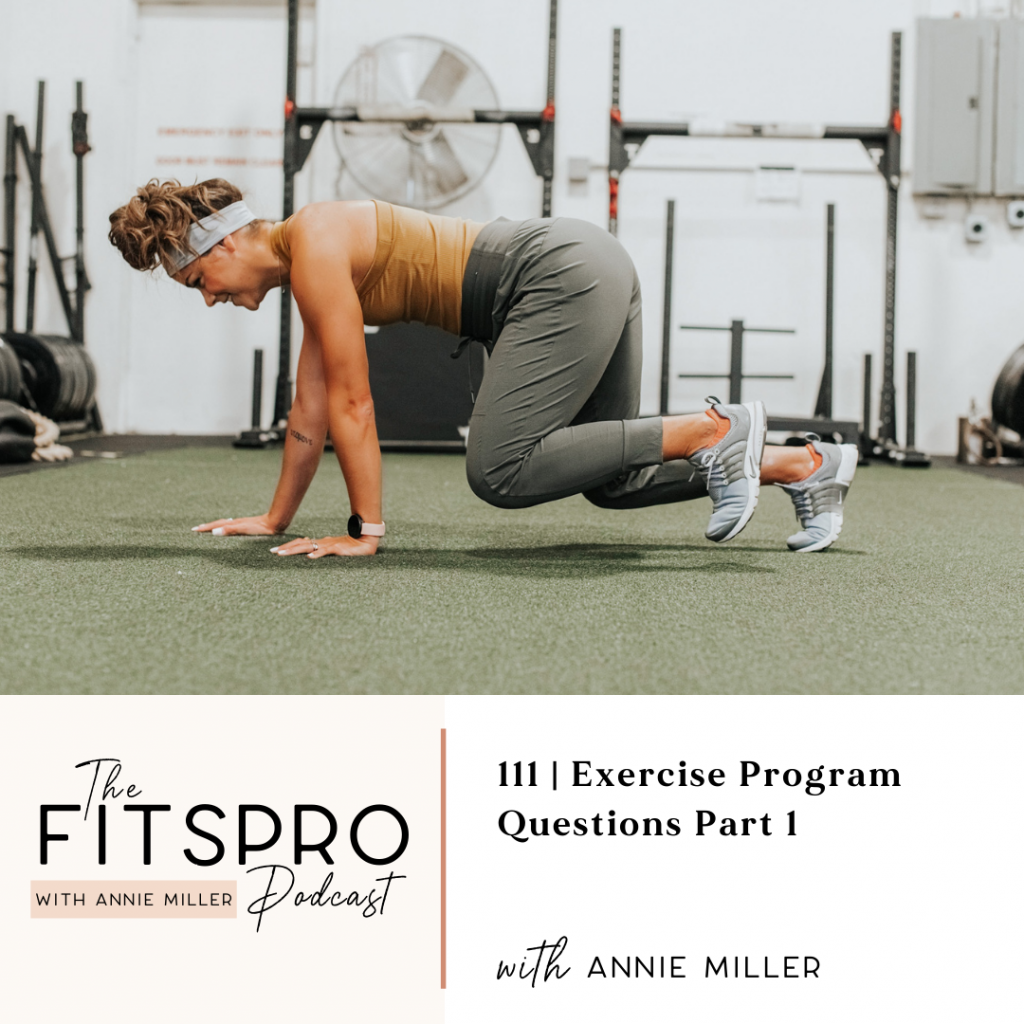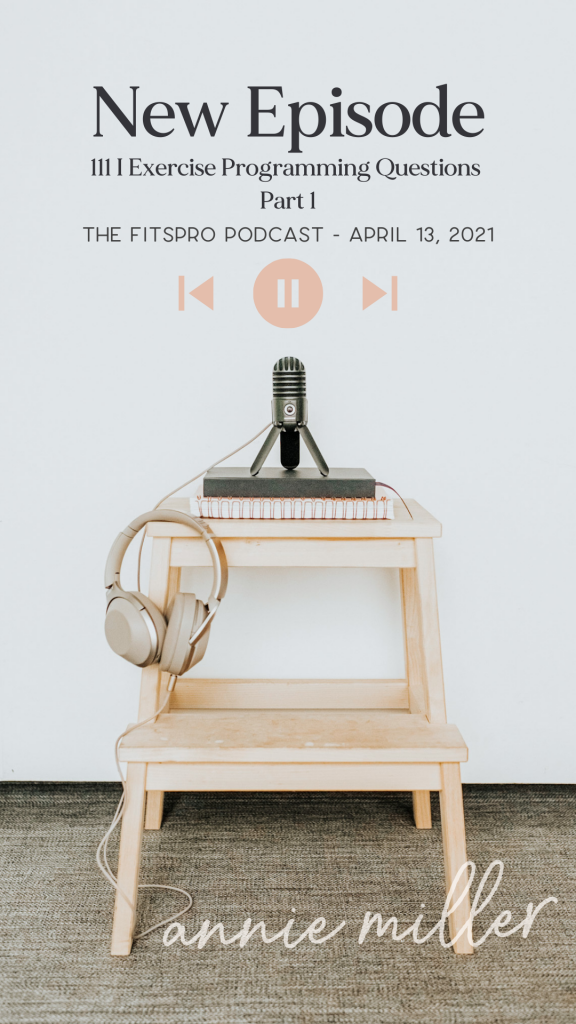the blog
welcome to
looking for something specific? find it here
Podcast: Play in new window | Download (Duration: 22:59 — 31.7MB)
Subscribe: Google Podcasts | RSS

Programming Q’s part 1
If you’re here for the business side of things, then go ahead and join my free on demand workshop, Your Biz | Your Way – 3 steps to build a profitable online health and fitness biz
And while you’re on the site, snag all the free resources – you’ll find goodies for trainees and coaches or entrepreneurs alike. Much love.
A while back I asked my instagram crew to drop all their programming questions. At the time, that was market research for something I’m working, VERY. SLOWLY. on behind the scenes. But I didn’t answer the questions at that time. So, here we are, using podcast 111 to rapid fire answer 22 programming questions.
These have been compressed and combined into like topics or questions. We’ll go one by one and hope I can get through these in a timely manner.
How you set up individual periodization for 1:1 client?
My individual periodization is always a combination of things. Their goals, time, assessment etc. Which we gather through our on boarding process.
I like to use 4-5 week training blocks, in which workouts repeat week to week. This way we can gauge progress, build solid patterns, and know what we need to progress next phase.
What are your first step during intake and how do you execute them? Assessments?
So, yep. For 1:1, I have used several types and combinations of assessment approaches.
Since taking the Active Life Immersion course, I use both the flexibility and mobility assessments as well as their strength/balance testing. Some pieces have been removed as they don’t apply to my clientele. I am currently reading through and trying different assessments and applications from Dr. Aaron Horschigs “Rebuilding Milo” book on addressing common injuries and building strong foundations for weight lifting.
What movements to assess during initial assessment?
If you don’t have a certification like FMS or gone through Active Life Immersion course, nothing is stopping you from creating your own assessment.
All you need to do is determine what type of training your athlete will be doing, and what information you need in order to determine that athletes baseline.
- This can include components like, but not limited to:
- Flexibility (passive ROM)
- Mobility (joint by joint active ROM)
- Strength balance (in reference to side to side differences as well as pushing and pulling etc)
- Muscular endurance
- Cardio respiratory endurance
So on and so forth.
The assessment I use from start to finish takes two weeks. So change your view or idea of assessment if you’re thinking one time consult. For you, maybe that’s true. But it’s more than likely NOT. Include what YOU need in your assessment, and take as long as you need to gather quality information.
How to assess for imbalances & how to work through muscle imbalances?
This is going to be a two part deal.
I mean, the most simple way to assess for imbalances to test side to side strength with lower body and upper body pushing and puling exercises. There’s no right or wrong choice here, but you need to be able to retest, and be consistent.
As far as imbalances like squat dominant or pushing dominant in comparison to deadlifts or pulling, that comes down to testing strength and/or endurance within those movements as well. This is all covered in Active Life Immersion course.
Take the course, or create your own testing that will give you the information you’re trying to get – squat to deadlift ratios etc.
It’s super important to note, you DO NOT have to test 1 RM. In fact I don’t see the need for 1RM testing for most of the population. The risk to reward is no there for me. I think 5 RM is a great test, or even choosing a weight and performing an AMRAP, then using that amrap score to determine a new weight and rep goal. This was an approach used in Dr. Jacob Hardens Prehab 101 seminar. I am unsure if there is an official test of the sort. Please feel free to correct me if I haven’t given credit.
Now, once you determine these imbalances, the second question was how to work through muscle imbalances.
Let’s say you find that you have discrepancies from left to right. You need to prioritize bringing up the weak side. Ways we can do this is adding extra volume the weak side in comparison to the strong side. Retest until both sides are testing within a rep of one another. People are often concerned that the strong side will suffer….
Your priority is bring up that weakling. You can then build both limbs together to maintain that balance.
How to pair movements – SUPERSETS/TRI SETS LOGIC
This is a super fun one for me. I love supersets. You’ve got so many options. Which is probably why it can be overwhelming as well. How do you know what to pair with what and be able to justify that choice.
If a client asks, “hey coach, why did you pair hip thrusts with RDL?” or “why did you pair shoulder press with pull ups?” or lateral raises for that matter.
What is the difference in pairing shoulder press with pull ups versus shoulder press with lateral raise?
…
If this was a class, you’d respond now. But the answer is that shoulder press + pull is super-setting opposing muscle groups. Whereas shoulder press + lateral raises is superseding the same primary muscle group, being the deltoids. Neither is right or wrong, better or worse. And I need you to understand that.
It’s a matter of training stimulus and goals of the program and/or needs of the client.
Let me just give you some options for superset/tri-sets and then you can use your logic to apply these to your programming:
Opposing muscle groups (Both muscle groups are likely still working as an antagonist or stabilizer)
Same muscle group (will require longer rest between sets due to the muscle group not getting rest from exercise to exercise).
Upper lower or unrelated muscle groups (potential to keep rest between sets lower because body parts are resting while non-related muscle group is *resting)
Hopefully that made sense. I’d love to hear and answer some more questions regarding supersets or exercise pairings.
How to know how to include different movements (vertical, horizontal presses/etc)?
Push pull ratios?
We’ll address these together.
First off, you should know what movements to include based on the assessment you did if you’re woking with a 1:1 client. Right?
That data will tell you if you need to focus on single limb work, which exercises or biases like vertical presses or pulling etc.
Speaking from a general standpoint, or group programming, we can look at broad standards and broad limitations.
We know that we should be stronger at pulling than pushing. Whether you do all pushing on one day and all pulling on another day, or you use them in the same workout, we have to look at volume of pulling to pushing.
You’ll see some people suggest 1:1 ratio and others lean more towards a 1:2 ration for PUSHING : PULLING.
We also know that pulling strength carries over to pushing strength. Soooo I tend to lean towards the 1:2 ratio – when not going off of an assessment.
That applies separately, to both horizontal and vertical pressing and pulling.
When programming, look at your daily breakdown of vertical push pull exercise selection as well as the volume of work. And then take a peeksie at your WEEKLY push pull volume.
Controversial movements (pull behind the neck etc)
Oooooo we love this.
Why we love this is because I consider myself a movement elitist. What is a movement elitist? I don’t know. Maybe there is an actual definition. But for myself, I went through phases of thinking, squats needed to be performed narrow stance, knees, out, toes forward, ass to grass. No pulling behind the neck or high pulls give you shoulder impingement injuries. Thinking neutral spine or death. How dare you have spinal flexion in a braced position? These types of absolutes within movement. That there is not grey area, or nuance or individual considerations to be made.
Make sense? Movement elitist
Here’s what I am going to say about this.
- Always ask questions – we had a BBA client the other day ask about the high pulls. She said she’d been taught that they were to be avoided and problematic. We explained why we had them programmed, sent photos of high pull positions from olympic lifts (as this athlete had experience with crossfit), as well as sending video with HOW to do them correctly, scapular positioning, etc.
- As YOURSELF why you think an exercise is bad or problematic. And ask what other options might be. In way of explanation and actual movement pattern.
- Be open to not fully knowing, and being in the grey area.
When a client experiences tightness, how to modify/communicate?
The only thing I will say for this one as it’s a bit out of my scope is in regards to communication with the client.
Tightness doesn’t mean short muscles, or injury. Tightness can be a sensation due to weakness in said muscle. You’d need to know how to assess for that.
Rule of thumb here would be to test flexibility of the area, mobility, and then also look at if it feels “tight” as the joint is closing or opening. If it’s when the joint is closing, it’s not tightness. Right? Because the muscle is shortening in length. You’d feel “tight” with lengthening of the muscle or opening the joint.
How to order movements?
You can truly do whatever you want and justify it.
Traditionally order would be in order of:
Power movements while you’re fresh
Strength & large compound movements
Isolation or single join work.
That’s about it.
We will finish these up in episode 112.
If you find value here, on The FitsPRO Podcast, then pretty please head over to iTunes, subscribe, rate and review the show. It means the world to me when you spread my message to more humans.
Want more podcasts? Click here to skim the archives.
P.S. Save this value packed episode for later over on Pinterest!
ALL THE LINKS YOU NEED:
Free On Demand Workshop: 3 Steps To Build a Profitable Online Health and Fitness Business
Supplements: Legion Athletics Code ANNIE for 20% off
Skincare: Fré Skincare Code FDBA for at least 15% off
Bags: Vooray Code ANNIE for 20% off
I'm an adventurous introvert from Vancouver, Washington who lives on sleep + "me time." I'm a lover of lifting weights, dinosaurs, real talk and traveling with my husband. I am here to help you move better, lift more, bust the myths of the fitness industry, and inspire you to love the process.
Hey you,
The name's Annie & you're reading my thoughts. Let's get acquainted.
the whole story >
looking for something specific? find it here
THE LINKS BELOW ARE AFFILIATE LINKS
SKIN CARE
Nutrition
brands I love
working against gravity
Fre skin care
favorites
blue light blockers
klassy network
code: fdba saves you 15% off
online TRAINERS
save $50
code: ANNIE saves you 20% off
You love my style, trust my reviews, and want more Annie Miller Concepts vibes in your life? Shop my favorite brands. You get awesome products and yours truly gets a little kick-back.


